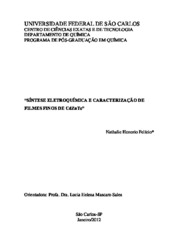Síntese eletroquímica e caracterização de filmes finos de CdZnTe
Abstract
Studies on the electrodeposition of semiconductor films has been developed primarily for the binary chalcogenides. However, there are several ternary systems that are poorly researched and have broad application spectrum, for example, the CdZnTe. In this sense, the objective of this work is to study the electrodeposition process of thin films of CdZnTe semiconductors and evaluate their optical properties, composition and morphology. In this work were used as substrates ITO and Pt electrodes, and CdSO4, ZnSO4, TeO2 solutions in the presence at different support electrolytes (C4H4O6KNa, acetate buffer (pH4) and (NH4)2SO4). The influence of supporting electrolyte in the electrodeposition process and films morphology was also evaluated. It was observed that the most suitable deposition media was sodium and potassium tartrate, because the films were more homogeneous. In this media was studied the influence of bath composition on the morphology, composition and band gap of the films. The films were grown at -1,2 V for 1h. Images obtained by FEG (field-emission scanning electron microscopy) revealed uniform films, and grain refinement was observed for coating deposited on ITO substrate. The films on ITO were analyzed by UV-vis to determine the band gap values, which varied from 1.5 to 1.7 eV, depending on the film composition. The deposition was also performed by multiple pulsed-potentials technique. The deposition potentials, based on the voltammograms, were -0.2, -0.9 and -1.2 V for Te, Cd and Zn, respectively. In these experiments the substrate was Pt and different deposition times were employee for each potential, maintaining a total time of 30 min. The morphology indicated Cd-rich clusters and Te-rich smooth regions, according to the EDX (Energy Dispersive X-ray) data. In order to promote a major change in the composition of ternary films, new deposition conditions were used, in which the elements quantities of the films were adjusted by changing the time on each applied potential and ions concentration. In this case the band gap values were around 1.8 eV, an intermediate value between the band gap of two binary semiconductors, CdTe and ZnTe. The analysis carried out by XRD (Diffraction X-rays) was also an indicative of ternary phase s presence, such as, cubic, tetrahedral and hexahedron. By the proposed methodology, was possible to obtain CdZnTe films with ternaries phases and control its grain size, optical properties and composition. Therefore, the main objective of this study was achieved, since it was possible to obtain films with different stoichiometry and thereby change its properties. The electrodeposits showed optical properties comparable with those of films obtained by physical techniques. Thus, the use of a technique relatively simple and low cost could easily be adjusted to produce these materials on a large scale and allow its use in photovoltaic systems, for example.
